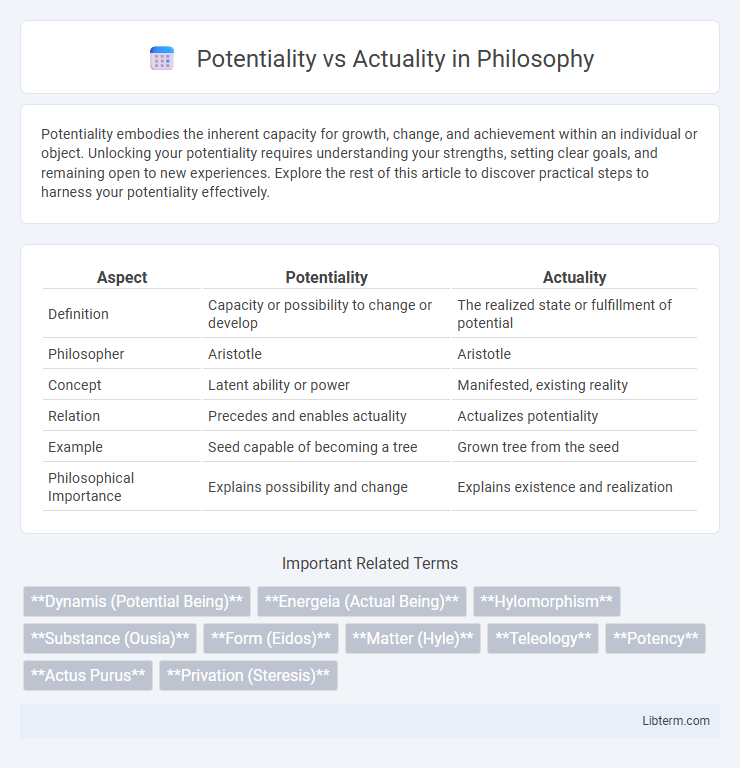Potentiality embodies the inherent capacity for growth, change, and achievement within an individual or object. Unlocking your potentiality requires understanding your strengths, setting clear goals, and remaining open to new experiences. Explore the rest of this article to discover practical steps to harness your potentiality effectively.
Table of Comparison
| Aspect | Potentiality | Actuality |
|---|---|---|
| Definition | Capacity or possibility to change or develop | The realized state or fulfillment of potential |
| Philosopher | Aristotle | Aristotle |
| Concept | Latent ability or power | Manifested, existing reality |
| Relation | Precedes and enables actuality | Actualizes potentiality |
| Example | Seed capable of becoming a tree | Grown tree from the seed |
| Philosophical Importance | Explains possibility and change | Explains existence and realization |
Understanding Potentiality: Definition and Origins
Potentiality, originating from Aristotelian philosophy, refers to the inherent capacity or possibility within an entity to develop into a particular state or achieve specific outcomes. This concept contrasts with actuality, which signifies the realized state of being or fulfillment of potential. Understanding potentiality involves exploring the latent qualities and conditions that enable future change or growth in various contexts such as physics, metaphysics, and human development.
Actuality Explained: What It Means in Philosophy
Actuality in philosophy refers to the realized state of being, where potential possibilities have been fully actualized or brought into existence. It contrasts with potentiality, which denotes the inherent capacity or possibility for change or development that has not yet been manifested. Philosophers like Aristotle emphasize actuality as the fulfillment of purpose or essence, marking the transition from latent potential to concrete reality.
Aristotle’s Contribution to Potentiality and Actuality
Aristotle's contribution to the concepts of potentiality and actuality lies in his metaphysical framework where potentiality (dunamis) represents the inherent capacity or possibility for change and development, while actuality (energeia or entelecheia) signifies the fulfillment or realization of that capacity. He posited that all beings possess both potential states and actual states, with change or movement being the actualization of potentiality. Aristotle's distinction established the foundation for understanding processes of transformation in nature, causality, and existence within classical philosophy.
Key Differences Between Potentiality and Actuality
Potentiality refers to the inherent capacity or possibility for change or development within an entity, while actuality is the realized state or the fulfillment of that potential. The key differences between potentiality and actuality lie in their temporal status--potentiality is future-oriented and latent, whereas actuality is present and manifest. In philosophical terms, potentiality represents what could be, whereas actuality denotes what is, highlighting the dynamic process of change and existence.
The Role of Change in Actualization
Change acts as the driving force in the transition from potentiality to actuality, enabling latent capacities to manifest into concrete realities. Through dynamic processes, potential states undergo transformation, achieving realization and contributing to the unfolding of existence. This actualization process highlights the fundamental interplay between possibility and change within metaphysical frameworks.
Examples of Potentiality and Actuality in Nature
Seeds represent potentiality as they contain the inherent capacity to develop into mature plants, while the fully grown tree demonstrates actuality as the realization of that potential. A caterpillar embodies potentiality with the genetic blueprint for metamorphosis, whereas the butterfly signifies actuality upon completing its transformation. Water stored as ice in glaciers holds potential energy, and its flow in rivers exemplifies actuality through kinetic energy and active movement in the ecosystem.
Potentiality and Actuality in Human Development
Potentiality in human development refers to the innate abilities, talents, and capacities that an individual possesses, awaiting cultivation and realization through experience and learning. Actuality represents the fulfillment and expression of these latent potentials as tangible skills, knowledge, and behaviors that actively shape personal growth and achievement. The dynamic interplay between potentiality and actuality drives continuous self-improvement and adaptation throughout the human lifespan.
Implications in Metaphysics and Ontology
Potentiality and actuality form foundational concepts in metaphysics and ontology, shaping the understanding of being and change. The distinction reveals how entities transition from possibility to reality, influencing theories of existence and causality. This framework informs discussions on essence, substance, and the nature of potential states within philosophical systems.
Modern Interpretations and Applications
Modern interpretations of potentiality versus actuality emphasize dynamic processes in cognitive science and artificial intelligence, where potential states represent unactivated neural patterns or algorithmic possibilities, and actuality corresponds to realized thoughts or computational outputs. Philosophers and scientists apply this framework to understand human decision-making, creativity, and machine learning, highlighting the transformation from latent capacities to concrete actions or solutions. This conceptual shift bridges classical metaphysics with empirical research, facilitating innovative approaches in neuroscience, robotics, and behavioral economics.
Potentiality vs Actuality: Philosophical Debates and Criticisms
Potentiality vs Actuality remains a central theme in metaphysical debates, specifically in interpretations of Aristotle's philosophy where potentiality denotes the capacity for change and actuality the fulfillment of that capacity. Critics argue that the distinction is too abstract, lacking empirical grounding and leading to ambiguities in explaining change and existence. Contemporary philosophers challenge its relevance, questioning whether the binary adequately addresses dynamic processes and the nature of being in modern ontology.
Potentiality Infographic

 libterm.com
libterm.com